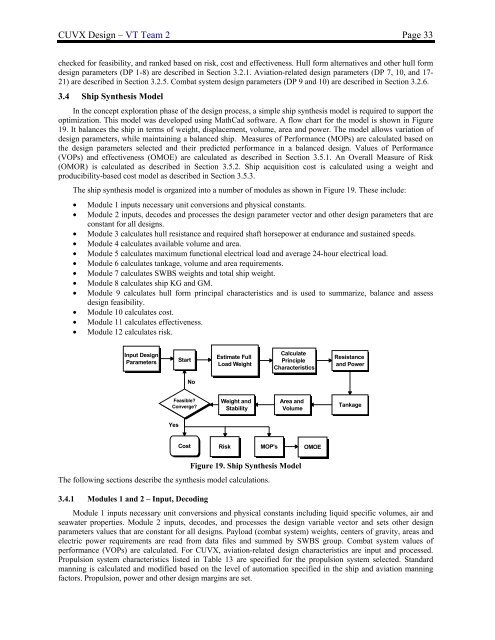CUVX Design Report - the AOE home page - Virginia Tech
CUVX Design Report - the AOE home page - Virginia Tech
CUVX Design Report - the AOE home page - Virginia Tech
You also want an ePaper? Increase the reach of your titles
YUMPU automatically turns print PDFs into web optimized ePapers that Google loves.
<strong>CUVX</strong> <strong>Design</strong> – VT Team 2 Page 33checked for feasibility, and ranked based on risk, cost and effectiveness. Hull form alternatives and o<strong>the</strong>r hull formdesign parameters (DP 1-8) are described in Section 3.2.1. Aviation-related design parameters (DP 7, 10, and 17-21) are described in Section 3.2.5. Combat system design parameters (DP 9 and 10) are described in Section 3.2.6.3.4 Ship Syn<strong>the</strong>sis ModelIn <strong>the</strong> concept exploration phase of <strong>the</strong> design process, a simple ship syn<strong>the</strong>sis model is required to support <strong>the</strong>optimization. This model was developed using MathCad software. A flow chart for <strong>the</strong> model is shown in Figure19. It balances <strong>the</strong> ship in terms of weight, displacement, volume, area and power. The model allows variation ofdesign parameters, while maintaining a balanced ship. Measures of Performance (MOPs) are calculated based on<strong>the</strong> design parameters selected and <strong>the</strong>ir predicted performance in a balanced design. Values of Performance(VOPs) and effectiveness (OMOE) are calculated as described in Section 3.5.1. An Overall Measure of Risk(OMOR) is calculated as described in Section 3.5.2. Ship acquisition cost is calculated using a weight andproducibility-based cost model as described in Section 3.5.3.The ship syn<strong>the</strong>sis model is organized into a number of modules as shown in Figure 19. These include:• Module 1 inputs necessary unit conversions and physical constants.• Module 2 inputs, decodes and processes <strong>the</strong> design parameter vector and o<strong>the</strong>r design parameters that areconstant for all designs.• Module 3 calculates hull resistance and required shaft horsepower at endurance and sustained speeds.• Module 4 calculates available volume and area.• Module 5 calculates maximum functional electrical load and average 24-hour electrical load.• Module 6 calculates tankage, volume and area requirements.• Module 7 calculates SWBS weights and total ship weight.• Module 8 calculates ship KG and GM.• Module 9 calculates hull form principal characteristics and is used to summarize, balance and assessdesign feasibility.• Module 10 calculates cost.• Module 11 calculates effectiveness.• Module 12 calculates risk.Input <strong>Design</strong>ParametersStartEstimate FullLoad WeightCalculatePrincipleCharacteristicsResistanceand PowerNoFeasible?Converge?Weight andStabilityArea andVolumeTankageYesCostRiskMOP'sOMOEFigure 19. Ship Syn<strong>the</strong>sis ModelThe following sections describe <strong>the</strong> syn<strong>the</strong>sis model calculations.3.4.1 Modules 1 and 2 – Input, DecodingModule 1 inputs necessary unit conversions and physical constants including liquid specific volumes, air andseawater properties. Module 2 inputs, decodes, and processes <strong>the</strong> design variable vector and sets o<strong>the</strong>r designparameters values that are constant for all designs. Payload (combat system) weights, centers of gravity, areas andelectric power requirements are read from data files and summed by SWBS group. Combat system values ofperformance (VOPs) are calculated. For <strong>CUVX</strong>, aviation-related design characteristics are input and processed.Propulsion system characteristics listed in Table 13 are specified for <strong>the</strong> propulsion system selected. Standardmanning is calculated and modified based on <strong>the</strong> level of automation specified in <strong>the</strong> ship and aviation manningfactors. Propulsion, power and o<strong>the</strong>r design margins are set.
















